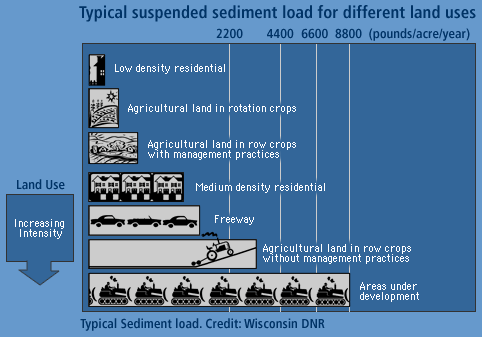 |
 |
EFFECTS OF AGRICULTURE NEAR WATER
![]()
- How can agriculture affect lakes and rivers?
- How can crop production affect water quality and hydrology?
- How can livestock production affect water quality?
- What can we do about agricultural pollution?
- Who can I call if I have a question or problem related to agriculture near water?
- What are some additional resources related to agriculture near water?
How can agriculture affect lakes and rivers?
Improperly managed agricultural activities may impact surface water by contributing nutrients, pesticides, sediment, and bacteria, or by altering stream flow. Fertilizer and pesticide use, tillage, irrigation, and tile drainage can affect water quality and hydrology. Livestock production practices, including riparian grazing, confined feeding operations, and manure management can also impact water quality.
Comprehensive farm plans and Best Management Practices (BMPs) address these activities to minimize degradation of water resources. Not all agricultural production adversely affects water quality, but because much of the state is agricultural land, there is a potential for impact on your local stream or lake. Regional differences in land use and lake characteristics will influence how susceptible your lake or river may be.
How can crop production affect water quality and hydrology?
Improper fertilizer management can contribute nutrients from excessive use of either commercial fertilizer or manure, improper application methods or timing, or inadequate BMPs to minimize leaching or runoff. Nitrogen moves easily as nitrate, dissolved in surface water runoff, drain-tile flow, or seepage to ground water. Phosphorus is generally bound to soil particles and may be carried to surface water through erosion or in solution. Nutrients cause excessive plant and algae growth in lakes and streams.
Crop production may also contribute pesticides to surface or ground water. Pesticides include herbicides, insecticides, fungicides, and other chemicals to control pests. Some pesticides or their breakdown products last a long time in soil or water. Some pesticides are very soluble in water and are more susceptible to leaching or runoff.
Thousands of acres of agricultural land in Minnesota have been tiled and drained to improve productivity. Drainage carries excess nutrients and pesticides and moves water more quickly off the landscape. Rather than soaking slowly into the ground, water moves rapidly into streams and lakes, changing the hydrology, or flow patterns. More water ends up reaching lakes and streams faster than it would from undeveloped landscapes. This has implications for water quality and biological communities.
Irrigation and chemigation (when pesticides are added directly to irrigation water) can increase the potential for nutrient and pesticide transport to nearby surface waters and ground water below agricultural fields. Base flow in nearby streams, lakes, or wells may be affected by intensive irrigation that draws down the ground water table.
Row-crop production can also increase the sediment load in lakes and rivers. Exposed soil is more susceptible to wind and water erosion. Cultivation near shorelines or on Highly Erodible Lands (HEL) can intensify erosion and sedimentation. Increased sediment can reduce flood capacity, instream flows, habitat, and aesthetics. Riparian filter strips, grassed waterways, crop residue, and other conservation practices can minimize soil loss.
How can livestock production affect water quality?
Manure contains nutrients (nitrogen and phosphorus), fecal coliform bacteria, and, often, pharmaceuticals used to enhance growth or improve animal health. When animals are allowed continuous, unrestricted access to streams and lakes, manure ends up in the water and riparian vegetation may be severely damaged. Exposed, compacted soil is more susceptible to erosion and is more difficult to revegetate.
Manure from livestock operations away from the water’s edge may also cause problems if it is not properly contained and managed. When animals are confined in feeding areas, vegetation is usually limited and manure is concentrated. Appropriate BMPs to collect, handle, and apply manure according to nutrient management plans have been adopted by many producers. However, there is still much work to address feedlots and manure management, including state and local policy development and implementation, education, and adoption of BMPs.
What can we do about agricultural pollution?
Working together at the watershed level, you can identify the potential influence of nearby or upstream agriculture on your lake or river. At the same time you should characterize other sources of nutrients or pollution, including on-site sewage treatment systems or municipal wastewater plants, lawn care practices, impervious surfaces, highway maintenance, construction, industrial sources, in-lake processes, and atmospheric inputs.
By identifying all potential sources and adopting strategies to manage or minimize impacts, you may be able to avoid conflict and work together to protect your lake or river. There are also incentive programs to assist farmers with adopting BMPs. As a last resort, enforcement may be necessary. Talk with your local Feedlot Officer, SWCD, or Planning and Zoning office for enforcement options.
Who can I call if I have a question or problem related to agriculture near water?
Check your local telephone listing, the “Who to Contact” section of the Minnesota Shoreland Management Resource Guide Web site, www.shorelandmanagement.org, or the Web sites listed below for:
- Soil & Water Conservation District (SWCD) (www.maswcd.org)
- County Feedlot Officer (not every county has one)
- Minnesota Pollution Control Agency (www.pca.state.mn.us), if your county does not have a feedlot officer
- Minnesota Department of Agriculture (MDA) (www.mda.state.mn.us)
- University of Minnesota Extension Service (www.extension.umn.edu)
- Minnesota Board of Water and Soil Resources (BWSR) (www.bwsr.state.mn.us)
- Natural Resources Conservation Service (NRCS) (www.mn.nrcs.usda.gov)
What are some additional resources related to agriculture near water?
- Non-Pesticide Voluntary Best Management Practices That Help Control Pests. 1998. Minnesota Department of Agriculture, U of MN Extension Service, Natural Resources Conservation Service
- BMPs for Water Quality. 1995. Conservation Technology Information Center
- The Minnesota Pesticide Management Plan. 1996. Minnesota Department of Agriculture
- Whole Farm Planning. 1997. Land Stewardship Project, U of MN Extension Service, Minnesota Department of Agriculture
